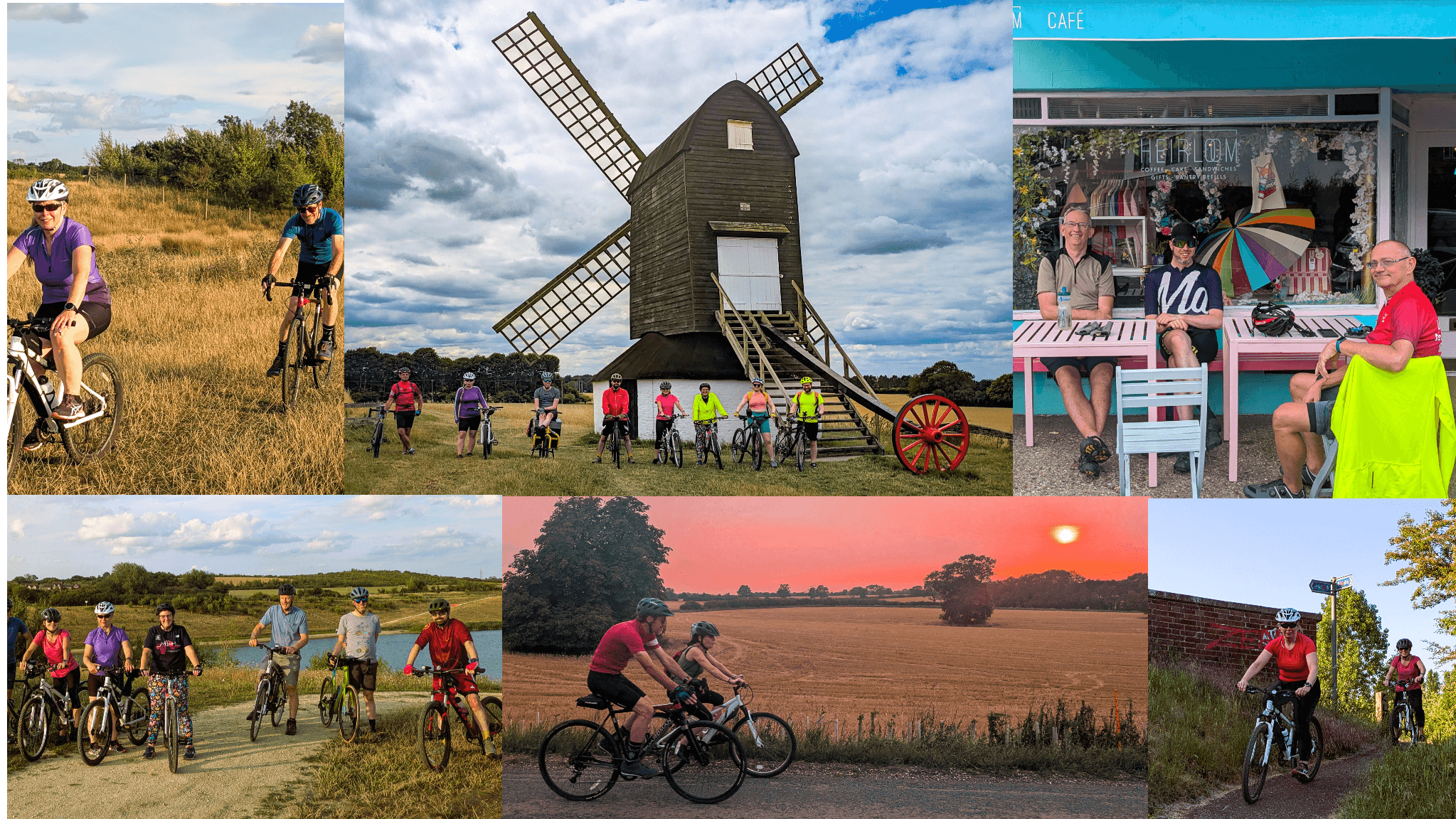BuzzCycles objects to the inadequate walking and cycling provisions, citing a lack of safe infrastructure, dangerous junctions, and the absence of a required Travel Plan.
Soulbury Road Planning Application: What You Need to Know
Planning Reference: CB/24/01897/FULL
Description: Development of 54 residential dwellings comprising 36 houses and 18 flats with associated access, servicing, parking, amenity space and landscaping.
The full details of the planning application can be found at CB/24/01897/FULL. To comment on the planning application, follow the consultation tab.
BuzzCycles Approach to Planning
Our approach to planning applications can be found on our planning page. In summary, we want to ensure that planning applications adhere to UK government policy. We’re not anti-car; our focus in planning applications is to create environments where walking and cycling are genuinely viable for everyday journeys like commuting, errands, school trips, and leisure.
Walking and Cycling Neglected: BuzzCycles’ Analysis
Leighton BuzzCycles Sustainable Transport Campaign Group has objected to the planning application to build a housing estate at the top of Soulbury Road in Linslade.
Whilst we have no objection to the location of the estate, provisions for walking and cycling to and from it are unsatisfactory.
The Design & Access Statement says that “[the plan will] improve walking, wheeling and cycling connections”, and that “[the plan] prioritises walking and cycling promoting environmentally-friendly transport options”, and also that “the development prioritises accessibility for all modes of transport with a focus on pedestrian, cycle and public transport connectivity”. In fact it does no such thing.
It actually acknowledges that “[there are] poor walking, wheeling and cycling connections” and “pedestrian pathways in this area currently lack a clear connection to other parts of the development”, and in fact it offers to improve this situation. However, pedestrian priorities are not fully implemented, and there are no priority or connectivity infrastructure features for cyclists at all.
Within the estate we appreciate the installation of cycle parking but there are no shared-use paths to separate pedestrians and cyclists from the road.
The design of the Soulbury Road access junction and the Derwent Road roundabout in particular do not meet the proclaimed aims, and the application does not include the Travel Plan that is required.
The estate exit road is very close to the brow of a hill and a 40mph speed limit and, despite the offer of a zebra crossing, this makes it dangerous for walkers and cyclists to cross Soulbury Road.
If a pedestrian or cyclist manages to cross Soulbury Road, the only other provision is a 2m path down to Derwent Road, which does not allow it to be shared between pedestrians and cyclists.
The claim that shops and schools are easily accessible does not stack up for the above reasons.
Strength in Numbers: Why Objections Matter
The number of people objecting to a UK planning application matters because it gauges public concern and the proposal’s potential impact on the community. In cases where the application fails to demonstrate sufficient cycling and walking access, many objections can emphasise the strength of local feeling regarding the inadequacy of sustainable transport provisions. This collective opposition can pressure the local planning authority to scrutinise the application more rigorously, which can then require the developer to make significant amendments to improve walking and cycling access.
Please comment/object here CB/24/01897/FULL, It only takes 2 minutes; it just needs a sentence or two. A few ideas are below:
- I object due to inadequate walking and cycling provisions. Despite claims of prioritising active travel and accessibility, the plans lack dedicated infrastructure and safe connections. The proposed access junction and brow-of-hill exit pose dangers for pedestrians and cyclists. The narrow 2m path to Derwent Road is unsuitable for shared use, hindering access to shops and schools. This application needs significant improvements for sustainable transport..
- I object as the planning application fails to deliver on its stated aim of improving walking and cycling connections. The current poor infrastructure is acknowledged, yet the plans offer no clear priority or connectivity for cyclists. The dangerous exit onto Soulbury Road and the insufficient shared path to Derwent Road make active travel unsafe and impractical. This development needs a fundamental rethink regarding pedestrian and cycle access.
- My objection to the Soulbury Road development (CB/24/01897/FULL) centres on the neglected needs of pedestrians and cyclists. While cycle parking within the estate is welcome, the lack of segregated paths and safe road crossings, particularly at the Soulbury Road exit, is unacceptable. The narrow path to Derwent Road further restricts active travel. The claim of easy access to amenities is unsubstantiated. This plan needs substantial revisions to genuinely support sustainable transport options for residents.
BuzzCycles Response In Full
We OBJECTED to the original proposal. Our comments from the original consultation have not been reflected in any meaningful changes to walking/cycling access, apart from moving the zebra crossing slightly, so once again we strongly OBJECT to the revised proposal.
We appreciate the level of cycle parking at the residences, and the pedestrian (but not cycle?) access to Linslade Woods.
We must bear in mind the CBC Travel Plans & Transport Assessments policy document, which states that “Travel Plans are critical to ensure use of sustainable modes is maximised and promoted”, and we must refer to Government guidelines (NPPF/PPG/LTN120) which state that “walking and cycling infrastructure must allow walking/cycling movements to take priority over vehicle movements”.
We note that the site area INCLUDES the Soulbury Road / Derwent Road junction roundabout and therefore NPPF/PPG/LTN120 requirements must apply to that roundabout as part of the development.
The design of the Soulbury Road access junction and the Derwent Road roundabout in particular do not meet these requirements.
The application includes a Transport Assessment and that means that a Travel Plan MUST also be created. We cannot see a Travel Plan document as part of the application.
In particular:
Revised Design & Access Statement Addendum:
Section 02.2 Site Strengths & Weaknesses states and acknowledges that “Poor walking, wheeling and cycling connections” and “pedestrian pathways in this area currently lack a clear connection to other parts of the development”. As we will see below, neither of these weaknesses have been fully addressed.
Section 02.3 Opportunities states that “[the plan will] improve walking, wheeling and cycling connections”. As we will see below, it only does that to a very limited extent.
Section 04.2 Planning states that “[the plan] prioritises walking and cycling promoting environmentally-friendly transport options”. Again, only to a very limited extent.
Section 05A.00 Access Strategy states that “the development prioritises accessibility for all modes of transport with a focus on pedestrian, cycle and public transport connectivity”. No, it certainly does not, see below. Pedestrian priorities are not fully implemented, and there are no priority or connectivity infrastructure features for cyclists at all.
Section 05A.00 Access Strategy states that “Pedestrian Access:… new footpaths.. zebra crossing connecting the site to the existing pedestrian network” – but there are no crossings over Derwent Rd or Bideford Green. So the estate is isolated from the Bideford Green area and its shops. If a zebra is considered necessary to cross Soulbury Rd safely then equally one must be considered necessary to cross Derwent Rd and Bideford Green, or how can people safely access the local shops?
Section 05A.00 Access Strategy states that “Cycle Access: promotes cycling through the provision of ample cycle parking for residents and visitors….secure storage.. lockers for apartments”. This section only describes cycle parking. Absolutely no mention is made about how cyclists safely access the local road network! The blind hilltop on Soulbury Road to the west makes it very difficult for cyclists to safely enter/exit the development if riding on the road. There are no 3m shared paths anywhere on the development or the immediately surrounding roads. In particular the new path on the south side of Soulbury Road west of Derwent Road is not shown to be 3m wide.
Revised Transport Statement Part 1 of 2:
Section 1.5 states that “This TS examines the transport and highways effects of the development and provision…. considering matters such as accessibility to non-car modes”. We do not think that much consideration has been given cycling accessibility in particular. As described above, the Soulbury Rd junction does not prioritise non-vehicle modes, and there is no zebra crossing over Derwent Road or Bideford Green to allow pedestrians to continue their journeys safely to the Bideford Road area and local shopping centre. There are no advance stop boxes for cyclists at the site junction or the roundabout.
Section 1.6 states that “This TS has been written with reference to best practice guidance from the DfT, NPFF” etc. Guidance may have been referenced but we do not think it has been adhered to because the road junctions design does not “allow walking/cycling movements to take priority over vehicle movements”.
Section 2.5 states that “the speed limit changes to 40mph circa 50m to the west”. Coupled with the blind hilltop at this point, this makes it very dangerous for cyclists to enter/exit the development and for pedestrians to cross even at the zebra crossing. Vehicles are highly likely to be travelling at over 30mph (section 2.9: “15% will be travelling at over 33mph”) at these points and walkers/cyclists will have almost no time to react due to the blind hilltop.
Section 2.12 states that “it can be demonstrated that no existing road safety issue is present near the site’s frontage to Leighton Road”. This is not a true conclusion from the previous statement. The access to the site is much nearer to the blind brow of the hill and the 40mph speed limit (only 50m to the west!) than the roundabout and therefore data concerning accidents at the roundabout have little relevance. The site access for walkers and especially cyclists is dangerous.
Section 3.5 states that “good levels of pedestrian accessibility to services”. Again, there is no zebra crossing on Derwent Road or Bideford Green to allow pedestrian movements to take PRIORITY over vehicular movements. The services are indeed nearby but they cannot be reached safely. In particular the lack of zebra crossings means there is no Safe Route To School for children to Greenleas or Southcott.
Sections 3.7 to 3.15 discuss the accessibility of various amenities by cycle. However they do not explain how cycles SAFELY and WITH PRIORITY enter/exit the site or circumnavigate the Soulbury Road roundabout. The route to town up/down is quite steep and unlikely to appeal to non-electrified cyclists. Cyclists would most likely use the parallel Bideford Green road down as far as Southcott School then access Soulbury Road where it is flatter. Whilst the developers obviously cannot do much about the steep main road, no consideration is given to how cyclists would access the site from Bideford Green via Derwent Road, the roundabout, and Soulbury Road. As described earlier the junctions are very offputting to cyclists due to the blind hill on Soulbury Road.
Section 4 explains that the NPPF mandates: “identifying and pursuing opportunities to promote walking and cycling……” and ENSURES that “sustainable transport modes are PRIORITISED… SAFE and suitable access .. for all users” and “applications should give PRIORITY FIRST to pedestrian and cycle movements both within the scheme and neighbouring areas” and “minimise the conflicts between pedestrians, cyclists and vehicles”. For all aforementioned reasons the development does NOT do this.
Section 5.1 states that “a new zebra crossing facility linking the site to the existing footpath on the western side of Bideford Green”. This statement does not make sense. The site access is on Soulbury Road to the west of Derwent Road. The new zebra crossing is on Soulbury Road west of the roundabout and therefore has no access to Bideford Green. No zebra crossing has been provided across Derwent Road to reach “the western side of Bideford Green”. There is also no footpath on the north side of Bideford Green, and no zebra crossing has been provided across Bideford Green. The exit of Bideford Green onto Derwent Road is a very wide bell mouth and not safe for pedestrians crossing it.
Section 5.20 states that “the site will be served with 2m footways on both sides of the internal access road”. The lack of a 3m shared path mandates that cyclists MUST use the internal access road, and that dictates that cyclists MUST enter/exit the site using the Soulbury Road junction. For reasons already explained, we consider that location dangerous for cyclists who therefore do not have PRIORITY over vehicles.
Section 5.21 states that “the site will connect to the wider pedestrian network… to the existing footpath on Bideford Green”. There is no existing footpath on the north side of Bideford Green. To reach the footpath on its south side, pedestrians must cross both Derwent Road AND Bideford Green without zebra crossings and therefore without priority over vehicles.
Section 5.28 states that “CBC have requested the Applicant review the ability to improve cycle connections to and from Leighton Buzzard rail station and town in line with LTN1/20…. [option 3] the 2m path on the south side of Soulbury Road would need to increase to a minimum of 5m to provide a dedicated footpath adjacent to a shared 3m two-way cycle lane”. A 3m shared path is by definition shared. There is no requirement for a 5m path, and we have never seen one of that width elsewhere. The 5m “requirement” is being used here to excuse the lack of any priority provision for cyclists! “The merging of cyclists on and off footway does not accord with LTN1/20” – Cyclists would not be merging if 3m shared paths were provided on both sides of Soulbury Road along with a shared crossing. There is plenty of room for a 3m shared path on the south side of Soulbury Road between the roundabout and the zebra crossing. However it seems cyclists are left with a vague promise to “discuss” just cycle road markings – hardly giving cyclists “priority”.
In summary:
There are no zebra crossings on Derwent Road or Bideford Green to match the one on Soulbury Road; and provision for cyclists at the complex junctions is non-existent being limited to some unspecified signage, with no 3m shared paths anywhere and/or no priority at on-road junctions. There is also no Travel Plan.
As a minimum for pedestrians, we request zebra crossings over Derwent Road and Bideford Green.
As a minimum for cyclists, we request a signed 3m shared path along the north side of Soulbury Road from the site junction to the crossing, a 3m shared path along the south side of Soulbury Road to the roundabout, a zebra crossing over Derwent Road, and a 3m path on the south side of Derwent Road to Bideford Green, with dropped kerbs. We have accurately measured the whole area and there is space for a 3m path both sides of Soulbury Road to/from the zebra crossing, and space both sides of Derwent Road and the north side of Bideford Green, WITHOUT moving ANY signs, utilities, lampposts, drain covers etc. There is no requirement for segregated 3m + 2m paths, and these occur nowhere else in Leighton Buzzard. However, new 3m shared paths are being installed around Leighton Buzzard as we speak.
If these 3m shared paths and crossings were installed, and a Travel Plan implemented, we would withdraw our objection.
For these reasons we strongly OBJECT to the proposal.
Thank you.
Leighton BuzzCycles Sustainable Transport Campaign Group




Leave a Reply